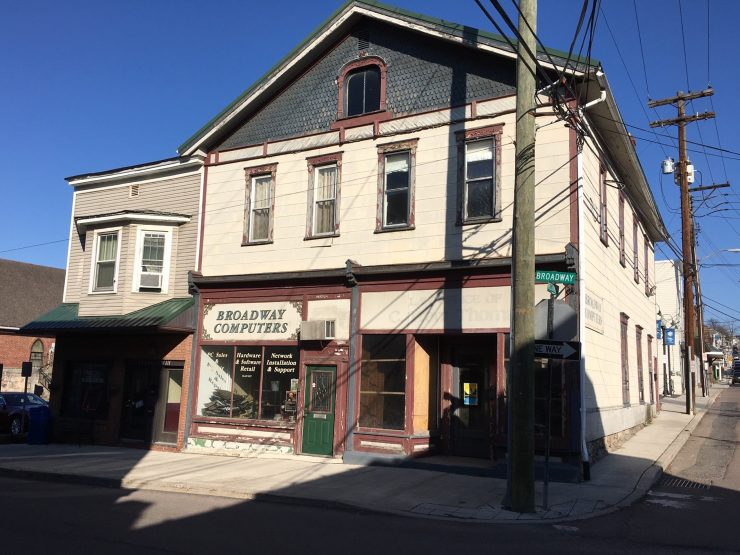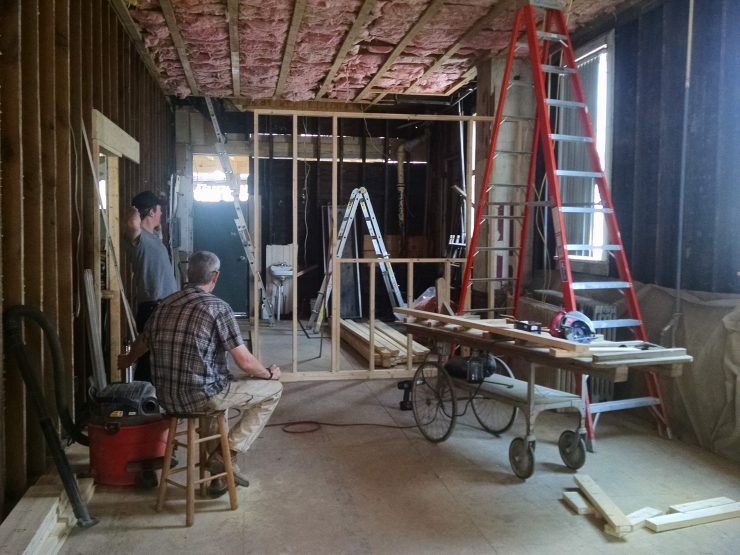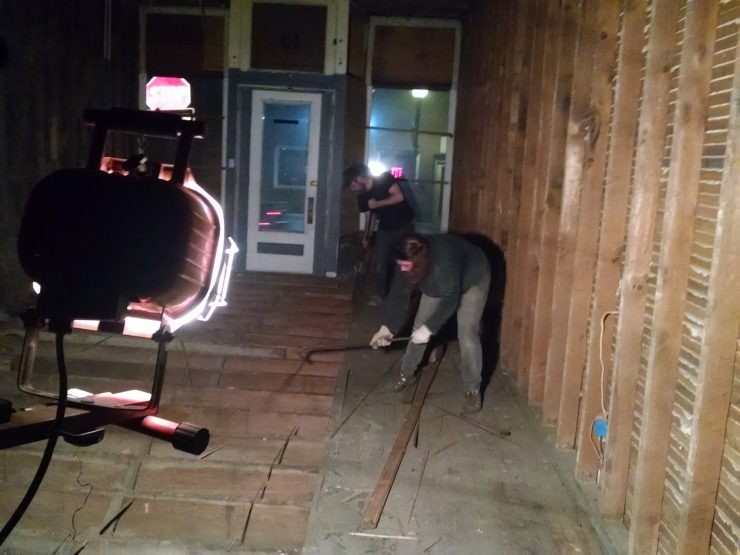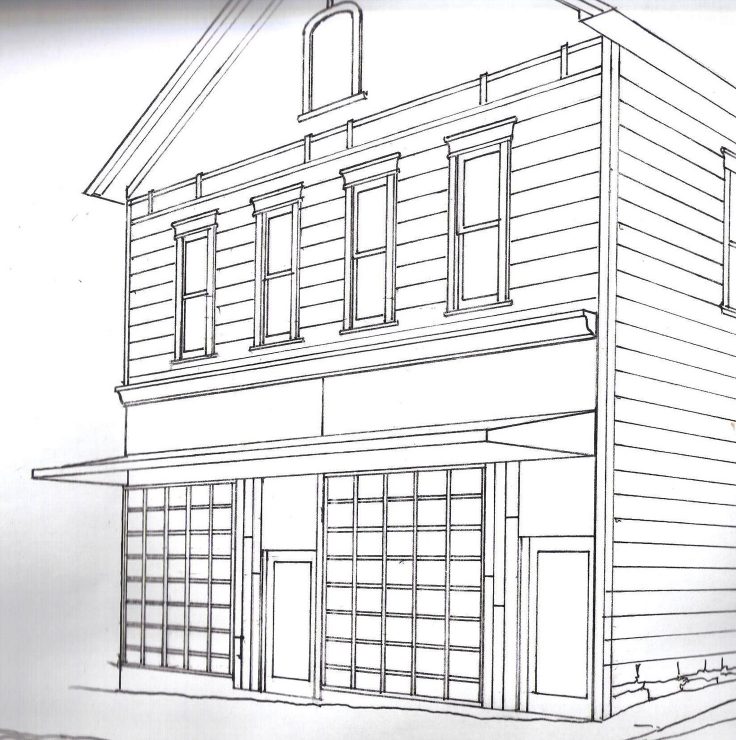
Another day, another cool build-out in a college town. This time it’s Frostburg, Maryland, home to Frostburg State University—go Bobcats!—and Clatter Coffee, located in the heart of the Arts and Enterprise District.
As told to Sprudge by John Felton of Clatter Coffee.
For those who aren’t familiar, will you tell us about your company?
Clatter Coffee will be the first to bring a true specialty coffee experience to Frostburg, a small college town in the mountains of western Maryland. There have been espresso machines, but not passion, not attention to quality of product or precision of craft.
We mean to make that kind of intentionality our brand (along with a customer-focused earnestness) and to bring it to every aspect of our business. Not least of which will be our build-out.

Can you tell us a bit about the new space?
In January we bought a 100-year-old two-story building in the heart of Frostburg, Maryland’s new Arts and Enterprise district, with two storefronts and two apartments above. Although essentially solid, there was a lot to do before we could get to the fun part. We began a somewhat surgical gutting, sorting, and setting aside every beautiful rough cut piece of wood, everything with potential for creative re-use. Community volunteers helped us pull nails and organize. As of this writing, we are finally able to start framing the actual shop as the customer will experience it.
The plan is to have the first storefront be the actual coffee shop, 15-feet x 45-feet, with a cozy variety of the seating you’d probably expect. Beyond that, an L-shaped bar that seats seven, and beyond that the kitchen.
The second side would have our stage (constructed of the old floorboards from the coffee side) and additional seating/community space/rentable space.
The design for the façade is about clean lines and lots of light, re-use, and juxtapositions of old and new, smooth/rough, urban/agricultural.
The first thing one will notice when entering are the walls, which will be a collage of horizontally running boards of different types of wood, colors, sizes, and textures, saved from the building renovation. Next, one would notice the bar, with a knowledgeable and welcoming barista presiding.

What’s your approach to coffee?
Our approach to coffee is that excellence is for everyone. Why not just do it right?
We want a regular cup of black coffee to impress. We want our customers to see that we are interested in all that a cup of coffee or espresso can be. In our market, we have to prove that we’re not about “fancy shmancy” snobbishness, but about quality work, attention to detail, and craftsmanship.
Still, all of our coffee focus is really about customer focus. We put effort and intention into each aspect of delivering this product, but not to draw attention to the barista or his/her knowledge. It is only partly to draw attention to the coffee, although that’s a necessary part, because what we want to communicate is, “This can be a really special thing. I put care into making it because I hope it will be a good experience for you.”
We like coffee crisp and bold with complexities worth talking about. We’ll offer both drip and manual brewing methods. Our espresso drink menu is straightforward, using milk from a nearby farm and only homemade syrups. We don’t think of that as too much of a statement—mostly just that it’s already in our skill set, will taste better, be unique to us, and set us apart from other places around here. It also fits our brand and the DIY zeitgeist of our area.
One of our big choices as far as approach to coffee was who to partner with as our roaster. We are really happy and excited to be partnering with Little Amps Coffee Roasters from Harrisburg, Pennsylvania.
“Our approach to coffee is still very much influenced by the Bay Area scene in the mid-2000s that first turned Aaron, our roaster, on to specialty coffee,” writes Peter Leonard. “Our brewed coffees are mostly from Central America and East Africa, which is par for the course these days.
Roasting coffee for the better part of six years has helped us hone in on what we like and what we want our coffee to taste like. We stay on the more developed end of roasting, which again may harken back to the pre-Nordic invasion, West Coast approach to specialty coffee in the States. We really like juicy, syrupy, fully body coffee with rich stone fruits, berries, and chocolates. Balanced acidity and sweetness are crucial as well!
We’ve always been focused on perfecting our roasting and brewing methods, but we have recently become more proactive in perfecting our green buying. We currently buy from a number of importers ranging from the very small, Colombia focused Tusa Specialty Coffee, to international but small-ish Collaborative Coffee Source, who luckily have a HQ in Central PA, to the ubiquitous specialty importer Cafe Imports. These companies, and a few others peppered in between those size levels, all have a slightly different approach to buying and we can flow between them based on what we’re shopping for. And what are we shopping for? Great coffee. Sometimes we need a value buy, or something blend specific, sometimes we want to splurge on a bag or two of something extra amazing, and sometimes we are looking for coffee from producers that we can connect and can grow with.
A great example of that is Isais Fernandez in Santa Barbara, Honduras. David Stallings of CCS helped us buy a few bags of Isais’ coffee last year, with the understanding we’d buy more this year. We were honored to have two of the five bags he produced this year, and to be the only roaster on the East Coast with this coffee. But it’s not just about the story or the boutique-ness of it. This coffee was SO nice. Our cuppings consistently produced strong notes of bergamot, orange essence, strawberry, and caramel. This is the essence of what we shop for: sweet, balanced coffees with a syrupy body and strong, clean finish.”

Any machines, coffees, special equipment lined up?
Our head barista is excited to be using an Athena Leva three-group. We’ll be using a Mahlkönig Tanzania and Mazzer Major for our main grinders, and a FETCO CBS 2132XTS 3L for drip coffee. We also look forward to pour-overs using Beehouse ceramic brewers and some other manual brews.
What’s your hopeful target opening date/month?
We plan to open in September.
Are you working with craftspeople, architects, and/or creatives that you’d like to mention?
Yes. Our project designer is Stephen Manger. He is a longtime compatriot, veteran chef, builder and carpenter, fine artist, draftsman, problem-solver, and brilliant if sometimes truculent conversationalist. He brings pragmatism to big ideas so they come true. His “Why not just do it right?” attitude, a keen aesthetic sense, and an appreciation for the potential of discarded things combine to bring us a look that is elegant, sophisticated, mutt-sturdy, and strong.
We are starting out with two experienced baristas: Greg Bender comes to us from Nashville, Tennessee, and Caleb Lange, from Grand Rapids, Michigan, both with well-honed skills, great ideas, and a taste for adventure.
Our web presence is being designed by Tyler Harvey.
Clatter Coffee is located at15 South Broadway, Frostburg, Maryland. Visit their official website and follow them on Twitter.
A previous version of this article incorrectly stated Frostburg was home to Morgan State College, and cheered the Morgan State Bears. We regret this error.
The post Build-Outs Of Summer: Clatter Coffee of Frostburg, Maryland appeared first on Sprudge.

